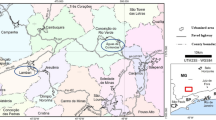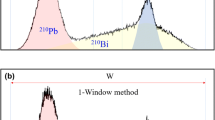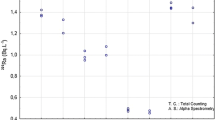Abstract
Lead-210 and radium-226 measurements by direct gamma assay can now provide a record of changing concentrations in lake sediments sufficiently reliable and precise to form a suitable basis for age/depth and dry-sedimentation-rate calculations. There are additional benefits in terms of non destructive sample preparation and simultaneous assay for other environmentally significant gamma-emitting radioisotopes (e.g. 137Cs and 241Am). Results from L. Fleet, S. W. Scotland illustrate the value of this approach especially in lakes with disturbed catchments where variable input of supported 210Pb has occurred.
Similar content being viewed by others
References
Anderson, N. J. & R. W. Battarbee, 1985. Loch Fleet, bathymetry and sediment distribution. University College London Working Papers, 10.
Appleby, P. G. & F. Oldfield, 1983. The assessment of 210Pb data from sites with varying sediment accumulation rates. Hydrobiologia 103: 29–35.
Battarbee, R. W., 1984. Diatom analysis and the acidification of lakes. Phil. Trans. R. Soc. Lond. B. 305: 451–477.
Battarbee, R. W., P. G. Appleby, K. Odell & R. J. Flower, 1985. 210Pb dating of Scottish lake sediments, afforestation and accelerated soil erosion. Earth Surf. Processes and Landforms, 10: 137–142.
Brush, G. L., E. A. Martin, R. S. DeFries & C. A. Rice, 1982. Comparison of 210Pb and pollen methods for determining rates of estuarine sediment accumulation. Quat. Res. 18: 196–217.
Durham, R. & B. G. Oliver, 1983. History of Lake Ontario contamination from the Niagara River by sediment radiodating and chlorinated hydrocarbon analysis I. Great Lakes Res. 9: 160–168.
Eakins, J. D. & R. T. Morrison, 1977. A new procedure for the determination of lead-210 in lake and marine sediments. NERC Report 8475, H.M.S.O., London.
Flower, R. J. & R. W. Battarbee, 1983. Diatom evidence for recent acidification of two Scottish Lochs. Nature 305: 130–133.
Gäggeler, H., H. R. Von Gunten & W. Nyffeler, 1976. Determination of 210Pb in lake sediments and air samples by direct gamma-ray measurements. Earth Planet. Sci. Lett. 33: 119–121.
Goldberg, E. D., 1963. Geochronology with 210Pb. In: Radioactive Dating. Int. Atom. Energy Ag. Vienna: 121–131.
Kahl, J. S., S. A. Norton & J. S. Williams, 1984. Chronology, magnitude and palaeolimnology record of changing metal fluxes related to atmospheric deposition of acids and metals in New England. In O. P. Brichner (Ed.) Geological Aspects of Acid Deposition, pp. 23–35.
Oldfield, F. & P. G. Appleby, 1984a. A combined radiometric and mineral magnetic approach to recent geochronology in lakes affected by catchment disturbance and sediment redistribution. Chem. Geol. 44: 87–93.
Oldfield, F. & P. G. Appleby, 1984b. Empirical testing of 210Pb-dating models for lake sediments. In E. Y. Haworth and J. W. G. Lund (Eds.), Lake sediments and environmental history. Leicester Univ. Press, Leicester, pp. 93–124.
Oldfield, F., P. G. Appleby & R. Thompson, 1980. Palaeoecological studies of lakes in the Highlands of Papua New Guinea. I. The Chronology of sedimentation. J. Ecol. 68: 457–477.
Author information
Authors and Affiliations
Rights and permissions
About this article
Cite this article
Appleby, P.G., Nolan, P.J., Gifford, D.W. et al. 210Pb dating by low background gamma counting. Hydrobiologia 143, 21–27 (1986). https://doi.org/10.1007/BF00026640
Accepted:
Issue Date:
DOI: https://doi.org/10.1007/BF00026640




